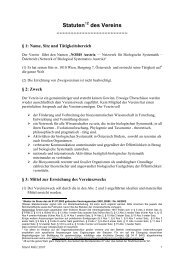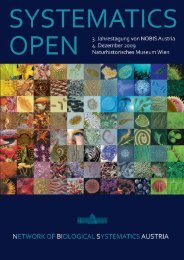4. Jahrestagung von NOBIS Austria 2. - 3. Dezember 2010
4. Jahrestagung von NOBIS Austria 2. - 3. Dezember 2010
4. Jahrestagung von NOBIS Austria 2. - 3. Dezember 2010
Create successful ePaper yourself
Turn your PDF publications into a flip-book with our unique Google optimized e-Paper software.
Is Babesia still Babesia?<br />
Walochnik, J. & Aspöck, H.<br />
Molecular Parasitology, Institute of Specific Prophylaxis and Tropical Medicine, Medical University of<br />
Vienna, Kinderspitalgasse 15, 1090 Vienna, e-mail: julia.walochnik@meduniwien.ac.at<br />
The babesias belong to the Apicomplexa (Alveolata; Eukaryota), as do the causative agents of<br />
malaria. Likewise they also parasitize red blood cells of vertebrates. Human babesiosis is a zoonosis<br />
transmitted by ixodid ticks, in which the relevant hosts are bovines, other mammals, and also birds.<br />
Most human cases are caused either by Babesia divergens, which occurs exclusively in Europe, or B.<br />
microti, which mainly occurs in the northeastern eastern parts of the USA.<br />
In 1888 the Romanian pathologist Victor Babes described Haematococcus bovis, a blood parasite of<br />
cattle. Later he found a similar parasite in the blood of sheep and named it H. ovis. One year after<br />
Babes’ first description, Smith and Kilbourne, described Pyrosoma bigeminum (later re-described as<br />
Piroplasma bigeminum) isolated from blood specimens of cattle suffering from Texas fever. Finally, the<br />
genus Babesia was established by Starcovici in 1893, uniting B. bovis and B. ovis, and later also<br />
including B. bigemina.<br />
Meanwhile, more than 100 species have been described, mainly according to their respective<br />
vertebrate hosts. In the past years, however, the validity of many species has been questioned and<br />
also new species have been described, including B. venatorum, Herwaldt et al. 2003 and B. duncani<br />
Conrad et al. 2006, both isolated from humans. Moreover, it has been shown that B. microti is more<br />
closely related to the genus Theileria than to other Babesia species. According to molecular data, five<br />
distinct groups can be discriminated within the Piroplasmidae: Babesia sensu stricto I, Babesia sensu<br />
stricto II, Babesia microti group, Theileria-like group and Theileria sensu stricto.<br />
Three cases of human babesiosis have been described in <strong>Austria</strong>, two caused by to the newly<br />
described species B. venatorum (Herwaldt et al. 2003, Gattringer et al. in preparation) and one by B.<br />
microti (Ramharter et al. <strong>2010</strong>).<br />
Herwaldt, B.L., Cacciò, S., Gherlinzoni, F., Aspöck, H., Slemenda, S.B., Piccaluga, P., Martinelli, G., Edelhofer,<br />
R., Hollenstein, U., Poletti, G., Pampiglione, S., Löschenberger, K., Tura, S., Pieniazek, N.J. .200<strong>3.</strong> Molecular<br />
characterization of a non-Babesia divergens organism causing zoonotic babesiosis in Europe, Emerg. Infect.<br />
Dis., 9, 942-948.<br />
Ramharter, M., Walochnik, J., Lagler, H., Winkler, S., Wernsdorfer, W.H., Stoiser, B., Graninger, W. <strong>2010</strong>. Clinical<br />
and Molecular Characterization of a Near Fatal Case of Human Babesiosis in <strong>Austria</strong>, J. Travel Med., Epub<br />
ahead of print.<br />
_____________________________________________________________________________<br />
Ber. Inst. Erdwiss. K.-F.-Univ. Graz, Band 15, <strong>2010</strong>; ISSN 1608-8166 47






